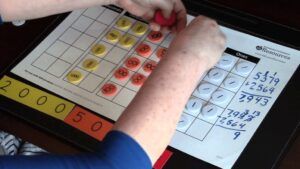Minuend and Subtrahend? If you don’t use those words on a regular basis in your math lessons, get ready for your math vocabulary lesson for the week! You’ll be talking subtraction like a pro in no time!

Minuend: a quantity or number from which another is to be subtracted.
Subtrahend: a quantity or number to be subtracted from another.
Subtraction Strategies: Part 2
Miss Subtraction Strategies: Part 1? Find it here!
 Decomposing/Composing in Subtraction:
Decomposing/Composing in Subtraction:Subtracting through decomposing and composing is a process similar to the one we showed in our
addition strategies post. If are using a partial differences strategy, you would always decompose the number into it’s respective place values (for example 73 could decompose into 70 + 3). However, this doesn’t always help because you would then end up subtracting negative numbers, which may actually lead to more confusion, especially for younger learners. Consequently, when teach decomposing and composing in subtraction, we like to rename the number. For example, in the problem below we have renamed 73 to 60+13 to allow for easier computation. It is important that students are able to decompose, or rename, numbers easily so they are more flexible with their numbers when they are using this strategy.
 Traditional with Place Value Disc and Strips:
Traditional with Place Value Disc and Strips:Typically, we teach subtraction with proportional tools such as base ten block or Unifix cubes. This does provide a beginning understanding of traditional subtraction, however when students go to do problems with pencil and paper they may not actually relate what they did with the base ten blocks to what they are doing in the algorithm. Research shows that we should go from proportional to non-proportional tools (such as coins or place value discs), then go to pencil and paper in order to help create a more conceptual understanding of the subtraction. In this example, we are using place value discs for the MINUEND and place value strips for the SUBTRAHEND. Notice how this connects to the traditional algorithm in a conceptual way for students.
Here’s a one-page document with all the subtraction strategies we’ve shared this week and last week:
Subtraction Strategies 
